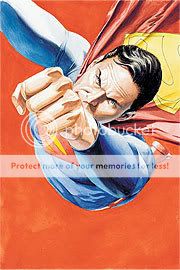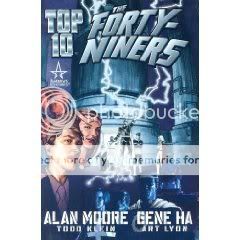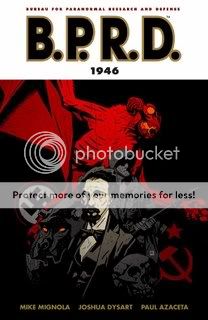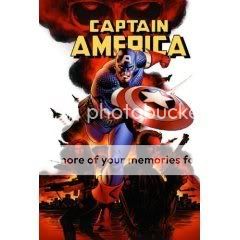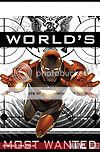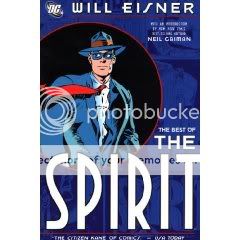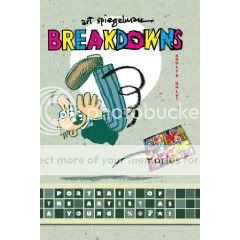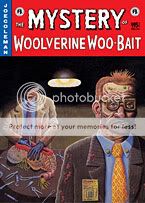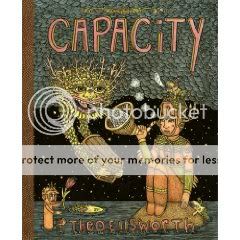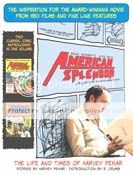Posts Tagged ‘comics reviews’
Comics Time: The Best American Comics 2006
January 30, 2009The Best American Comics 2006
Anne Elizabeth Moore, series editor
Harvey Pekar, guest editor
Joel Priddy, Kim Deitch, Anders Nilsen, Lilli Carré, David Lasky, Ben Katchor, Alison Bechdel, Joe Sacco, Justin Hall, Chris Ware, Rebecca Dart, Ivan Brunetti, Jonathan Bennett, Jaime Hernandez, Esther Pearl Watson, John Porcellino, David Heatley, Lloyd Dangle, Hob, Gilbert Shelton, Olivia Schanzer, Alex Robinson, Jessica Abel, Seth Tobocman, Terisa Turner, Leigh Brownhill, Rick Geary, Tom Hart, Kurt Wolfgang, Jesse Reklaw, Lynda Barry, Robert Crumb, writers/artists
Houghton Mifflin, October 2006
320 pages
$22
Pretty much all of the big hardcover comics anthologies published by non-comics publishers over the past few years have been obsessed to the point of neurosis with proving the worth of the medium to readers of pictureless literature. Nowhere has goal been made more explicit than in the introductions to this volume provided by editors Anne Elizabeth Moore and Harvey “American Splendor” Pekar. Moore does it using that good-ol’ “the disreputable comics of yore have blossomed into a bona fide ninth art, but look out, they’d still get you kicked out of study hall” reverse-psychology formulation, while Harv once again recounts his “bitten by a radioactive Crumb” origin story and how he’s been fighting for comics-as-literature since the days of the undergrounds.
But the funny thing is that compared to Ivan Brunetti’s Yale-published Anthologies of Graphic Fiction or Chris Ware’s McSweeney’s collection, this book feels the least concerned with making a swing-for-the-fences, for-the-ages case for the greatness of comics. Perhaps it’s because it’s shorter; perhaps it’s because the fairly well-documented neuroses of its editors are nonetheless of a different, less labor-intensive variety than those of Brunetti and Ware. I think it’s most likely because Moore (who selected 150 candidates for inclusion here) and Pekar (who picked his 30 favorites from that pool) cast their net a little wider, or at least in a different direction, than the anthologies we’re used to. The aforementioned Brunetti and Ware efforts tended to draw their conclusions from a fairly familiar comics-as-high-art canon: classic newspaper strips, the undergrounds, Raw, people published by Fantagraphics and Drawn & Quarterly during the ’90s, and Kramers Ergot. This edition of Best American drags in some alt-weekly strips, some World War 3 Illustrated alums, some vets of non-“Big Two” altcomix imprints like AdHouse and Alternative, self-publishers who aren’t from the Fort Thunder/Highwater/NON/Kramers tradition, etc.
The result is less cohesive than more high-falutin’ efforts–given its mission statement, it seems odd to lead off with an extended stick-figure superhero parody from Joel Priddy, for example. It has its fare share of duds, including a few of the then-young anthology series Mome‘s less impressive stories, excerpts from longer slice-of-life fiction works that come across inert outside their original contexts, and a lengthy autobio piece from Jesse Reklaw about his childhood cats that basically made me want to punch him and every member of his family in the face for mistreating and neglecting helpless animals for year after year. Moreover, I’ve never had much use for the aesthetics of the aforementioned alt-weekly strips or World War 3 Illustrated stuff, and that trend remains un-bucked. And I don’t know if it’s me coming to a canon naturally or the canon shaping my preferences or what, but I think on a surface level the material here is on average less visually sophisticated and appealing than what you’d find in one of those Brunetti books.
But there’s a sense of playfulness and fun in these selections that you also don’t find in this anthology’s more studied counterparts, a feeling that you’re engaging with artists who don’t usually get this high-profile an outlet for their work, or this high-level an imprimatur for it either. For example, I think the book’s real revelation, and also its longest contribution, is the non-fiction “La Rubia Loca” by Justin Hall–a cartoonist best known for gay erotica–which tells the story of a manic, possibly schizophrenic woman’s ill-fated trip through the Mexican wilderness with both insightful sensitivity and genuine page-turning suspense. Another standout is “Rabbithead,” an ambitious, flawed, bizarre, singular work of dark fantasy by Rebecca Dart that functions like a cross between a good Guillermo Del Toro movie (I’m told they exist!) and Richard McGuire’s “Here.” This is not to say that the usual suspects are absent–far from it. There are several strong, oft-anthologized pieces in here: from Joe Sacco (on Iraq), David Heatley (on his Dad–say what you want, that strip’s funny!), Chris Ware (on the “history of comics”). But there are also some killers I haven’t seen outside their original homes. John Porcellino’s “Chemical Plant/Another World” is the real world-beater among them, astonishingly evocative of a particular setting yet also masterful in how it translates lived experience into abstraction, prefiguring similar works by the likes of Kevin Huizenga or Anders Nilsen. Robert Crumb’s “Walkin’ the Streets,” from a recent (!) issue of Last Gasp’s Zap, wows as usual with its powerfully rendered art, this time coupled to a comparatively deadpan recounting of life with his profoundly dysfunctional family–and to a happy ending! Ben Katchor’s “Goner Pillow Company” is as pitch-perfect as everything else I’ve read by him and makes me wish his Metropolis material gets collected toot sweet. There’s even an astutely selected passage from Anders Nilsen’s underrated chronicle of vaguely post-apocalyptic perambulation Dogs and Water.
I think maybe the best way to understand this anthology is as a replacement for a visit to an altcomix convention like MoCCA or SPX. At those shows, you stroll around with eyes and wallet open, picking up stuff from the big Fanta table in the corner, but also taking a few chances with unfamiliar stuff, or with work from someone you’ve seen at every one of these shows for years but never quite clicked with. You go out of your comfort zone a bit, you take some risks that don’t pay off, but, to quote Pekar’s introduction, “you may be pleasantly surprised.”
Comics Time: Final Crisis
January 28, 2009Final Crisis #1-7
Grant Morrison, writer
J.G. Jones, Carlos Pacheco, Jesus Merino, Marco Rudy, Doug Mahnke, Christian Alamy, art
DC Comics, May 2008-January 2009
30something story pages or so each, I think
$3.99 each
WARNING: SPOILERY SO LOOK OUT
I find the way some people online spend paragraph after paragraph picking Grant Morrison comics apart for hidden meanings and insight into the nature of life and art and thought distasteful, because that’s the behavior of Baptists at Bible college, not grown-up art critics. Even so, I couldn’t help but realize after I finished reading through all seven issues of Morrison’s uniquely Morrisonian DC event comic that it could be roughly summed up in the words of Newman from Seinfeld: “When you control the mail, you control…information.” Right from the opening scene in which the New God Metron pops up on Anthro the First Boy on Earth and brings him both “knowledge” and fire, most of the book’s superheroic and supervillainous action revolves around attempts to transmit or block the transmission of information and/or light–which, as Barry “The Flash” Allen implies, are basically the same thing if you’re running fast enough.
On the side of light, thought, knowledge, the flow of information, you have Metron and his circuit pictogram, the Guardians and Green Lanterns and their will-powered light, the Tattooed Man and his magic ink, Lex Luthor and the Ünternet, the Ray transmitting himself around the world to pass on Metron’s anti-Anti-Life circuit, Nix Uotan’s Multiversal monitoring, the Monitors themselves as “beings of pure thought,” Barry Allen being reconstituted out of pure information to tell the other Flashes how they can stop Darkseid, the Miracle Machine taking relativity a step further by turning thought into matter, the Supermen of the Multiverse as an army of explicitly “solar-powered” heroes. On the side of darkness, mindlessness, ignorance, restriction of information, you’ve got Libra killing the heroes’ premiere telepath and literally extinguishing the Human Flame, the Justifier helmets shutting down thought (and blocking all the characters’ eyes), Darkseid’s fall creating a singularity out of which not even light can escape, the hanging of the Calculator – i.e. the villain whose M.O. is the transmission of information, “Dark Side,” Mandrakk the Dark Monitor who dwells in the darkness “where all stories end,” the Anti-Life transmission rendering all communication devices useless. Like a prism breaking light down, the comic’s storyline gets more manic and disjointed as it goes. Heck, I think you can make the case that the slow breakdown of a coherent art style into a panoply of pencillers before everything is finally refocused into a single (albeit different) art style is an effective reflection of that refraction. Not necessarily a persuasive case, but a case.
The message seems clear: Life and good is light and thought and our ability to communicate them both, death and evil is darkness and hate in thought’s place and being prevented from thinking or feeling or speaking freely. That’s an interesting and not entirely uncontroversial set of equivalencies Morrison is making here. If it’s less subversive than Jack Kirby’s original conception of life and Anti-Life, which as Tom Spurgeon has pointed out was an argument that taking up arms against Anti-Life is itself Anti-Life, it is at least subversive in its own, different way; I know I’m not the only reader of this comic who spits “Anti-Life!” in response to events in the all-too-real world. Anti-Life is in demand.
But you know what? I’m not sure how interesting any of that really is to me, in the end. Much more exciting than any kind of Lost-message-board “here’s what it’s about“-style theorizing was the simple experience of reading and enjoying a crazy-ass superhero story in which I almost never had any clue what was going to happen next! The supervillainy was seedy, joyless, and unnerving–the Fourth World meets the Black Lodge. The pacing was Morrison at his most fearless and formally inventive, at times as dizzying and dazzling as the Hernandez Brothers; I, for one, certainly never expected to read a superhero event comic that reminded me of “Flies on the Ceiling” (both formally and thematically!). The art got a little shaky in the middle, and I think at this point in his career we have to blame Morrison for necessitating a cast-of-thousands art-team approach in so many of his projects, but it’s bookended by career-best stuff from J.G. Jones and Doug Mahnke, images I can and do look at for a long long time. All the heroic protagonists got cool triumphant beats. The Twitterable/Facebookable/Google Chat Statusable quotes were almost unceasing. It was knowingly self-parodic at times and satirical at others and deadly serious at still others. Yes, Batman: Last Rites and Superman Beyond really should have been part of the main story somehow in that they’re the main storylines for the two biggest characters DC has, and it would be nice if they were going to be collected in the main Final Crisis trade between issues 4 & 5 and 5 & 6 respectively, but you know what? Batman killed the embodiment of evil and died, his body was cradled by Superman, and he was reborn as a caveman on the last page. In the words of the Dark Knight himself, “DO I MAKE MYSELF CLEAR?” I loved this flawed, weird, complex, simplistic, fun, wondrous comic to pieces.
Comics Time: Top 10: The Forty-Niners
January 26, 2009Top 10: The Forty-Niners
Alan Moore, writer
Gene Ha, artist
DC/WildStorm/America’s Best Comics, 2005
112 pages, hardcover
$24.99
Originally written on November 18, 2005 for publication by The Comics Journal
This is a nice little comic from Alan Moore. That in itself is remarkable–did you ever think that in this stage in his career Moore would be producing “nice little comics”? In wildly ambitious books like Watchmen and From Hell Moore was the pioneer of the comic-narrative-as-intelligent design, in which meticulously devised plot points move like intricate clockwork toward an inescapable conclusion which consequently reveals to the reader the baroque planning in all that has gone before. (And I’m not even just talking about Moore himself there–the story arcs for his villains Ozymandias and William Gull follow the very same pattern.) And as extraordinarily rich and rewarding as the comics Moore created with that approach have been, it’s nice to see him kick off his shoes and relax a bit. Creating art that’s not quite so ostentatiously inorganic–telling a story rather than creating a parlor game, in other words–can be rewarding too.
That’s not to say that this prequel to Moore’s “Hill Street Blues with superhero cops” dramedy Top 10 is entirely free of the Bearded One’s sometimes too-heavy authorial hand. A sequence in which an unsuccessful sexual coupling is juxtaposed with a brutal and sexualized multiple murder (by vampires, no less) is an almost shockingly facile use of montage for a writer of Moore’s skill and experience. A subplot in which a young former World War II flying ace and his mustachioed German commander fall in love feels less like something two actual people are actually doing and more like Moore saying, “hey, they’re gay, and that’s okay!” Well, of course it is. And? Dopiest of all is a bit in which a partially viewed headline from a newspaper seen via a time machine (“NAZIS RUN USA” reads the obviously incomplete block text) manages to convince several otherwise intelligent characters that a couple of Nazi mad scientists will succeed in their plot to conquer America, despite the fact that an actual newspaper in a Nazi-ruled U.S. would no more need to run such a headline than the New York Times would need to announce to its readers “BILL CLINTON IS PRESIDENT” in mid-1994.
But The Forty-Niners remains fun because of its delightful setting–Neopolis, a city full of superhumans–and structure–like a TV series, it has ongoing interweaving A, B, and C plots, and individual “episodes” alternate between focusing on this or that set of characters. These two wide-open parameters give Moore a lot more room to play than either his ABC line’s more straightforward genre pastiches like Tom Strong or Tomorrow Stories (cute but depthless) or his didactic magickal opus Promethea (wonderful to look at, but I didn’t buy this kind of stuff when it was being fed to me in Catholic school; is it supposed to be easier to swallow from a guy who invented his own snake god?). Moore uses Romanian vampires as an Eastern European mafia, has superhero cops arrest superhero civilians for vigilantism, and creates a female German defector named Sky Witch who rides around on a rocket-powered broom-lookin’ thing. He’s clearly having a good time, but at the same time creating a story that doesn’t depend on contrast with preexisting archetypes or on castles-made-of-sand metaphysics for its oomph.
And he’s helped quite a bit by artist Gene Ha, who skillfully tempers a dynamic naturalism that would be at home in one of Marvel’s Ultimate titles by giving nearly all of his characters slightly overemphasized noses that look like they’ve been blown into cheap tissues about forty times that day and legs that look like they’d comfortably fit on the body of Tommy Tune. They look real, but they look vulnerably cartoonish too. And his designs for Neopolis itself are wondrous–it’s probably the best-realized superhero city since Anton Furst’s Gotham in the first Tim Burton Batman picture. Colorist Art Lyon bathes Ha’s figures in sepia to convey the story’s post-war “pastness”; sure, it’s a little easy, but it’s also a little gorgeous. Kinda like the book itself.
Comics Time: Tokyo Tribes Vols. 1 & 2
January 23, 2009Tokyo Tribes Vols. 1 & 2
Santa Inoue, writer/artist
Tokyopop, 2005
200 pages or so each
$9.99 each
Originally written on May 8, 2005 for publication in The Comics Journal
You don’t need to know which of New York City’s five boroughs is also known as “Shaolin” to grok that the pop cultures of the Far East and the inner-city West have been happily cross-pollinating at least since Jim Kelly’s afro entered the dragon. From the RZA’s obsessive referencing of films like Five Deadly Venoms and Shogun Assassin to Jay-Z’s name-checking of Tokyo’s Bathing Ape clothing label to the almost neurotic Japanophilia of Gwen Stefani’s legion of big-name hip-pop producers, urban American tastemakers have happily pillaged Asian culture. Tokyo Tribes attempts to flip the script by grafting hip-hop fashion, patois, and pseudo-Shakespearean self-aggrandizement onto the visual language of manga. And woof, what a mess it makes.
Tokyo Tribes follows a pair of estranged friends, Kai and Mera, who have come to be leaders of rival Tokyo street gangs. While Kai’s “tribe” is a relatively peaceful one, Mera’s is puppet-mastered by Bubba, a genuine crimelord with the girth and coif of the Kingpin and the appetites of Caligula. Various shady enterprises and deceitful underlings cause the two to come into conflict, but the plot mechanics are practically an afterthought; the real focus is on the moments of excess–hip hop’s true stock in trade, after all.
In this regard writer/artist Inoue is probably a student of Brian DePalma’s Scarface, the Oliver Stone–penned epic of bad taste that has become hip-hop’s over-the-top stylized-crime Talmud. That film’s moments of outrageous violence–the chainsaw scene, “Say hello to my little friend!”–work with a breezily cheesy and offensive gusto, modeled as they are after similarly larger-than-life moments in the gangster films of the ’30s and embedded within one of the greatest displays of sceneryphagy in cinematic history. Inoue has simply detached them from context, played up their most lurid aspects, and expected his audience’s affinity for the cultural touchstone’s he’s hitting upon to help him pull it off.
It doesn’t work. We are hardly a handful of pages into the book before an overzealous rookie cop has an eye gouged out by a member of one of the tribes, in full view of not only a street full of passerby but of his own partner. I understand that we’re to see the tribes as the power in the city, but even The Godfather acknowledged that in attacking policemen is taboo for even the most powerful of criminal organizations. Bubba, meanwhile, is quite explicitly modeled after Scarface‘s Tony Montana, perhaps after 30 years and 300 pounds were added on; a globe in Bubba’s opulent foyer affixed with the legend “Fuck the World” invites direct comparisons to Montana’s similar “The World Is Yours” motto, and those comparisons are not favorable. (Whoever thought we’d yearn for the subtle nuances of the script that gave us the phrase “This town’s like a giant pussy just waiting to get fucked?”) His incredibly, and I mean that in every sense of the word, graphic and sexualized outbursts of violence are so out of left field and so far removed from the strictly-business ethos of hip-hop crime that they deal the book a blow it’s unlikely to recover from. This suspension-of-disbelief-shattering aspect of the story is only heightened by the “censored” bars superimposed, with Inoue’s approval, on nude body parts throughout the series: We’ve just seen a fat old man anally rape a young boy until the victim’s body literally bifurcates, and now all of a sudden we’ve got to hide nipples behind black bars? (On the other hand, the censored bars do mitigate against Inoue’s tendency toward making all his woman characters either ethereal damsels in distress or straight-out sex objects, all too often literally so.)
Inoue’s line is loose and idiosyncratic, different than either the slickness of typical male-oriented manga or the bubbly design of the graffiti aspect of hip-hop culture. Since it belongs fully to neither world, it can occasionally bridge them rather effectively. Perhaps its strongest moment is in the rooftop-to-rooftop chase and swordfight that kicks off Volume 2, a truly thrilling sequence that takes advantage of comics’ ability to expand and juggle time and space in the context of action. (In its way, it’s reminiscent of some sequences from another East-West fusion, Quentin Tarantino’s Kill Bill films, which of course bore a comics influence far more formal, and more profound, than David Carradine’s Jules Feiffer-cribbed Superman speech.) But Inoue immediately cuts the strength of the scene off at the knees by revealing that the dizzying heights our characters have been battling in are actually close enough to the street that one of them can drop down to the ground and incur barely a scratch. And then a rival gangster drives up wearing a samurai helmet and driving a tank. Sigh. Inoue forgets that for all its braggadocio, hip hop’s roots are as “the black CNN,” a mirror–a funhouse mirror, perhaps, but a mirror nonetheless–on the reality of life in the big city. I don’t care if the city in question is Tokyo rather than the South Bronx or South Central–it’s still got to be real.
Comics Time: B.P.R.D. Vol. 9: 1946
January 21, 2009B.P.R.D. Vol. 9: 1946
Mike Mignola & Joshua Dysart, writers
Paul Azaceta, artist
Dark Horse, November 2008
144 pages
$17.95
Another Hellboy-verse tale, another litany of misery, failure, and impending doom. Like the proverbial pink elephant, now that I’ve noticed the mile-wide undercurrent of fatalism flowing like the Styx through all of Mike Mignola’s interconnected Hellboy and BPRD comics over the past few years, it’s impossible to stop thinking about it. But that’s a good thing, because it prevents me from writing off this look at one of the early adventures of Hellboy’s old mentor Professor Bruttenholm (pronounced “Broom,” which I don’t think I’d ever put together until now) as something of a throwaway throwback. Both the main Hellboy minis and the parallel BPRD books have gotten pretty far away from early HB‘s two-fisted occult-Nazi slugfests, so when you open a book with that familiar mix of cybernetic Nazi gorillas, sentient decapitated SS-captain heads in jars and so forth, you might think Mignola and his collaborators are going for the easy stuff. Not so: Mignola and his co-writer Dysart root nearly all the important character bits in the trauma of the then-just-completed Second World War. Much of what happens in the central storyline, centered around a Nazi vampire-virus doomsday weapon to be released when the Reich falls, happens because of how American and German soldier characters recoil from the thought of both inflicting and enduring further horrors. There’s a genuinely difficult sequence in which the protagonists’ noble intentions are thwarted by circumstance and they end up perpetrating the exact atrocity they promised not to. Mignola and company also make the effort to push the Nazis out of the “I hate those guys” boo-hiss villain mold and connect their blasphemous black-magic doings in the story to the real-world mentality that led them to systematically slaughter millions of people.
Which brings us back to do, if you will, and how the supernatural evil in Mignola’s stuff seems to be slouching toward victory. One of the main characters here is Varvara, an unnervingly cute little Russian girl in a frilly white dress who runs the Soviet Union’s BPRD equivalent. Turns out she’s actually a demon in human form who hangs around our world because she loves watching people get hurt. If there’s a better encapsulation of the prevailing tone of the Hellboyverse over the past few years, I’d like to see it. I wouldn’t mind seeing it drawn by Paul Azaceta just like this one is, by the by. His loose, simplified, seemingly photoreffed style reminds me of Emmanuel Guibert gone pulp, and he executes all the creepy images and military hardware his writers serve to him with panache. It’s exciting, emotionally resonant genre storytelling; with All Star Superman over and depending on how you feel about Captain America, I’d say it’s another chapter in the best ongoing super-comic on the stands today.
Comics Time: Captain America by Ed Brubaker
January 19, 2009Captain America: Winter Soldier Vols. 1 & 2, Captain America: Red Menace Vols. 1 & 2, Civil War: Captain America, The Death of Captain America Vols. 1 & 2
Ed Brubaker, writer
Steve Epting, Mike Perkins, Michael Lark, John Paul Leon, Marcos Martin, Lee Weeks, Butch Guice, artists
Marvel, 2004-2008
various page counts
various prices
I think you can count the number of times the title character smiles in this long, high-quality run of superhero comics by Ed Brubaker on one hand and have three fingers left over. Considering how that’s two different guys we’re talking about here, that’s really rather impressive. I suppose it’s not necessarily a particularly noteworthy achievement to have crafted such a uniformly bleak work of superheroics in this the age of SUPERHEROES IS SERIOUS BUSINESS, but what distinguishes Brubaker’s work from similar efforts by many of his contemporaries is not just a grimness of tone but a moderation of it. Brubaker appears in total control of the milieu he has developed for Captain America–as I’ve described it many times in the past, a perfect blend of countless Cap flavors, including World War II hero, post-9/11 symbol, black-ops badass, Steranko spy, and Star-Spangled Avenger, set in a world of super-powered espionage and terrorism. By tweaking the plot, the antagonist, the setting, or the combination of supporting characters just so, Brubaker can emphasize any one of those notes at any time. It’s the rare comic where armed corporate security forces opening fire on protesters can share space in a storyline with a severed cybernetic arm springing to life and incapacitating a roomful of scientists and neither feels ridiculous or out of place. (Wow, I just re-read the review I wrote of a couple Cap issues from this time last year, and it’s a little uncanny how closely what I just wrote echoes what I wrote then. But I guess masterful craft leaves an impression.)
In rereading the bulk of Brubaker’s run in a handful of sittings, though, it really is a certain sadness that emerges as the dominant impression. Brubaker’s Steve Rogers is a very lonely guy, held in awe by almost everyone who knows him but feeling like his adult life is a series of deaths and regrets. Nearly all of his supporting characters are similarly haunted by their violent pasts (and presents!). Brainwashing emerges as a recurring element, and perhaps as a metaphor for how we can’t control what our minds and memories give precedence to. Heck, the Red Skull actually kills his archenemy and doesn’t even take a single panel to gloat over it. To find another superhero comic this intrinsically unhappy with violent conflict you’d have to go back to Jack Kirby’s Fourth World saga–yet here as there the action is both thrilling and constant, and drawn with flair by really the originators of the new Marvel house style, Steve Epting, Mike Perkins, and several seamlessly slotted fill-in artists here and there. Strong, ultimately pretty unusual stuff.
Comics Time: Kramers Ergot 7
January 16, 2009Kramers Ergot 7
Sammy Harkham, editor
Alvin Buenaventura, assistant editor
Sammy Harkham, Shobo Shobo, Martin Cendreda, Walt Holcombe, Shary Boyle, Jerry Moriarty, Aapo Rapi, Ted May, Nick Main, Tom Gauld, Geoff McFetridge, Chris Cilla, Tim Hensley, Daniel Clowes, J. Bradley Johnson, James McShane, C.F., Kim Deitch, Chris Ware, Jacob Ciocci, John Brodowski, Jaime Hernandez, Matt Furie, Anders Nilsen, Ivan Brunetti, Carol Tyler, David Heatley, Dan Zettwoch, Johnny Ryan, Mat Brinkman, Eric Haven, Conrad Botes, Josh Simmons, Richard Sala, Jesse McManus, Rick Altergott, James Thurber, John Hankiewicz, Ben Katchor, Frank Santoro, Seth, Leif Goldberg, Blanquet, Blex Bolex, Will Sweeney, Kevin Huizenga, Adrian Tomine, Florent Ruppert, Jerome Mulot, Anna Sommer, Ben Jones, Pshaw, Jonathan Bennett, Helge Reumann, John Pham, Matt Groening, Xavier Robel, Joe Daly, Souther Salazar, Ron Regé Jr., Gabrielle Bell, writers/artists
Buenaventura Press, December 2008
96 comically huge pages, hardcover
$125
The massive, gutterless, green white and orange panels of Frank Santoro’s silent Iraq War morality play. The masterful repetition and variation of John Hankiewicz’s three-page classroom vignette. The way Ben Katchor uses space to force your eye back and forth and effortlessly draw you to the conclusion of his strip about a woman reluctant to date a man who works in an ugly building (a LOL moment). Chris Ware’s lifesize baby. Mat Brinkman’s massive red white and black monsters. Josh Simmons’s jaw-droppingly bleak horror story, its dense panels fluttering by so quickly it almost feels like you’re watching the comic rather than reading it. Eric Haven’s use of blue. Carol Tyler’s huge block-letter “NUTS!” Ivan Brunetti and Kevin Huizenga forcing you to flip this gigantic book around. Jacob Ciocci using a Seal lyric as the philosophical lynchpin of a psychedelic freakout (another LOL moment). The electric guitar soundwave in the middle of John Brodowski’s page. The delicious candy-colored nostalgia of the vintage bottlecaps lining Kim Deitch’s strip. All those James McShane circle panels. The way the traditional altcomix layouts of Tim Hensley, Dan Clowes, and Jaime Hernandez’s strips make you feel like you’re reading a book from a land of giants. Double that with Adrian Tomine’s spread. Tom Gauld’s “two guys in a weird, large, isolated environment” schtick being used to tell the story of Noah’s Ark like some lost Edward Gorey project. Aapo Rapi’s blue yellow and green Grimm Cabbage Patch Kid fairy tale. Walt Holcombe’s rock-poster title page. Matt Groening’s dorm-poster contribution. Matt Furie’s menagerie. John Pham’s evocation of the gray urban nightscape in his strip about stray dogs. Gabrielle Bell’s spy thriller (!). Ben Jones & Pshaw’s color-coded gag strips. Ruppert & Mulot’s vertiginous stairway strip. Sammy Harkham’s two-tone sunset. Seth’s Porcellino-like tribute to Thoreau MacDonald. Anders Nilsen’s pastels. Helge Reumann’s cycle of violence. Shobo Shobo’s bright yellow endpages and nearly useless Where’s Waldo table of contents. Sammy Harkham’s creepy front cover and Shary Boyle’s creepy back cover. Conrad Botes ending things on the downest down note he could play.
When you open these massive covers and flip through these massive pages and read these massive comics, you’ll find things that lots of things that knock you out immediately and lots of things that work really well once you read them. You’ll also find lots of things that don’t work on a canvas this size, and a number of things that probably don’t work at all. But all told, a decade from now or two decades from now when someone asks you what this decade was like in alternative comics, this is the book you’re going to hand them. This is our era. You were there.
Comics Time: Speak of the Devil
January 14, 2009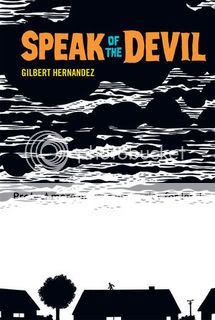 Speak of the Devil
Speak of the Devil
Gilbert Hernandez, writer/artist
Dark Horse, October 2008
128 pages, hardcover
$19.95
Buy it from Amazon.com
Hmmm, you know what? Not quite sure what to make of this one. It’s Gilbert Hernandez, so it’s beautiful, in this case almost freakishly so. The image of the moon and clouds in the night sky in the first couple of panels is enormously evocative and engrossing–as cliche as it sounds, you really are instantly transported into the world of this comic. The book’s glossy paper takes Beto’s blacks to a new level of shiny, greasy oiliness. They almost look wet. He can lay out a page like nobody’s business and has the same knack for doing the unexpected but just-right with his panels that John Bonham had with his drums, from a dialogue sequence where word balloons always accompany a shot of the person who isn’t talking to a view of a make-out session that features a positioning of the two involved parties I’d never seen depicted before yet instantly recognized.
The story isn’t quite so smoothly done. I buy the character work in the beginning–I understand why each of these people is making these unusual choices. I was almost thrown by the first outbreak of violence, but then it turns out to be something different and less grievous than I thought it was, so I was back on board with what I thought was a really astute take on troubled teenagedom. I could even go along for the ride when the killing started because of the people with whom it started. I watched Snapped, I know these things happen. But as things get progressively worse, I never quite bought the ease with which our protagonists become a Mickey and Mallory menage a trois, particularly the stepmother, who seemed basically happy with her life if a little kinkier than she felt comfortable letting on with her husband. I understand that we’re not in the “real world” of something like the Palomar material but in the heightened reality of the “Fritz-verse” of b-movies Beto is slowly converting to graphic novel form, but I still feel like the work requires psychological integrity if not psychological realism, and I don’t see how guileless serial murder flows from what we’ve seen in these characters up until that point.
And there’s also this weird disconnect between the astonishingly graphic violence–seriously, this thing is brutal–and the strangely prudish sexual material. Which, I’m sorry, erotic thrillers should have nudity, particularly erotic thrillers from Gilbert freaking Hernandez, the most refreshingly no-holds-barred tackler of sexual material in alternative comics. Am I saying that I want to see the sexy female characters naked? Well, yeah, that’s partially what I’m saying, same as how I wanted to see Superman actually punch people in Superman Returns–it’s sort of the point. And while we’re at it, this isn’t Hollywood, we don’t have the MPAA breathing down our necks, we can show dick, too, as Beto has countless times in the past. To do a Brian DePalma story about peeping toms with several sex and masturbation scenes and not show any nudity at all…it’s just weird, it left me wondering why that decision was made and distracted when the over-the-top violence kicked off, like, “this is okay but nipples aren’t?”. At first I assumed it was because this was originally a serialized Dark Horse comic, but Dark Horse also published Sin City and Hard Boiled, both of them insanely violent comics with a decent amount of nipplage. I dunno, it’s odd, don’t you think? I have a feeling I’ll be returning to this comic anyway, because like its sister book Chance in Hell it’s magnetic and extremely revealing in terms of how much of its author it puts on display, but it doesn’t quite all click for me the way thematically (and even visually) similar works like Black Hole click.
Comics Time: Skyscrapers of the Midwest
January 12, 2009Skyscrapers of the Midwest
Joshua W. Cotter, writer/artist
AdHouse Books, June 2008
282 pages, hardcover
$19.95
The collected Skyscrapers of the Midwest is more than the sum of its parts–and that, friends and neighbors, is really, really saying something. All four of Skyscrapers‘ original issues were dynamite: The first felt like a revival of the old-school one-man anthology altcomix, the second revealed it to be the seeds of a larger story that developed through the remaining three issues, each of which held together as a discrete storytelling unit (gilded with entertaining ACME-style ephemera) but adding depth, breadth, and power to the overall novel. The second issue was, in fact, virtually the perfect comic book. That it sits comfortably between the covers of a larger graphic novel without overwhelming it–that it in fact is enhanced by its new surroundings–is more of a testimonial to Josh Cotter’s work here than I could ever offer.
It’s not just that Cotter’s art take funny-animal-era Crumb crosshatching and doughy character designs; it’s that he applies them to Ware-informed layouts and and subject matter, with the occasional Kupperman-level black-humor interlude thrown in. It’s not just that Cotter matter-of-factly introduces and kills with a seemingly neverending series of crackerjack visual symbols–migraine locusts, cancer squids, God robots, death jetpacks, angel kittens; it’s that sweeping silent sequences where he really lets loose with this stuff segue seamlessly into painfully accurate, rigorously observed recreations of awkward childhood conversations at home, at school, in church. It’s not just that it’s an autobiography that never comes out and says so and is all the more effective for it; it’s that it’s also an equally sensitive and unsentimental portrait of other people in town whose inner lives Cotter couldn’t possibly have access to. It’s not just that it joyously recreates the way pop fantasy figures like He-Man and Marvel superheroes gave kids an outlet for their imaginations above and beyond whatever frequently dreary, yet often wondrous material was actually there; it’s that it also viciously lampoons the material for its benighted assumptions about everything from women to justice, and for the way it literally preyed upon the insecurities of children to make money. It’s not just that it unflinchingly depicts the go-nowhere futility of cancer-ridden, unexamined lower-middle-class life; it’s that it’s also a totally moving tribute to how the relationships we form with one another are the things that last and give us meaning in the face of man’s cruelty to man, man’s cruelty to nature, and God’s cruelty to everything. Skyscrapers of the Midwest, in other words, is simultaneously one of the warmest and the coldest comics ever. It’s brilliant and devastating, and I love it.
Comics Time: Nocturnal Conspiracies
January 9, 2009Nocturnal Conspiracies
David B., writer/artist
NBM, December 2008
124 pages
$14.95
However their images may resonate with the Jungian collective unconscious, dream comics really do exceed even autobio as sequential art’s most solipsistic genre, a relentlessly inward-looking cataloguing of the contents of the artist’s own head. They’re personal. So I don’t mind filtering this review of a collection of dream comics by the great French cartoonist David B. through my own, equally personal primary reaction to it: They remind me of my own dreams! Like B., I frequently return to action-adventure-thriller scenarios in my dreams, violent vignettes involving skulking, spying, fleeing, and above all the imperative to kill or be killed. Given B.’s background, his antagonists are frequently figures from France’s World War II experience, or terrorists; given mine, my enemies were usually figures from popular culture–zombies, Aliens, mafiosi (terrorists were late entrants). It was enormously comforting for me to discover another mind so consumed with murder and mayhem even when asleep.
The greatest pure stylist of any of the big European cartoonists whose work gets translated these days, B.’s genius lies in how his comics do the same thing that dreams do: Break down full-fledged ideas into simpler, more symbolic totems that remain recognizably of a piece with some waking concern or other but gain power through their abstraction and fluidity. His angular, expressionist style is complemented with both an equally proficient use of curves and an equally stark and judicious deployment of thick blacks and midnight blues–it’s really perfect for evoking the half-remembered mystery and chaos of dreams, even though in actuality those dreams are at the time as realistic-looking as our waking lives. Though the comparatively rigid layouts and the placement of narrative captions at the top of most panels leads to an unpleasantly staccato feel at first, eventually you get used to it–or B. does, I’m not quite sure which; at any rate he occasionally abandons the captions altogether, usually to enhance the shock and the you-are-there feel of what he’s presenting. Beyond the engrossing dreams themselves, Nocturnal Conspiracies of course serves as a showcase for the many, many things David B. draws as well as anyone in the business, from warriors and weapons to hair and breasts; there’s a panel in here that’s the loveliest depiction of sexual penetration I’ve ever seen in a comic. Though less ambitious both narratively and visually than Epileptic, Babel, or the fable comics he’s done in MOME, this is delightful work.
Comics Time: Invincible Iron Man #8
January 7, 2009Invincible Iron Man #8
Matt Fraction, writer
Salvador Larroca, artist
Marvel, December 2008
32 pages
$2.99
Here’s a good example of how event comics can hijack a perfectly good ongoing series. Matt Fraction’s take on Iron Man fortuitously jibes so neatly with Jon Favreau and Robert Downey Jr.’s that its opening arc read like an adaptation of a nonexistent movie sequel. It featured Iron Man/Tony Stark on top of the world but cognizant of his limitations and the danger of his war machines. Now, however, the events of Secret Invasion mandate that Stark be removed from his perch atop the S.H.I.E.L.D. defense/espionage agency, to be replaced by the publicly rehabilitated captain of industry and serial killer Norman “The Green Goblin” Osborn–instantly, Fraction must throw the character’s previous mien and milieu out the window. Indeed, everything that happens in the comic reminds us of the noxious ideas from other comics upon which they are contingent. For example, the presence of Osborn as Stark’s successor is due to a ludacris plot twist from Secret Invasion, best analogized by Newsarama commenter Old Doom as “…O J Simpson cuts off the head of Osama Bin Laden on tv, and they make him the head of the C I A.” Osborn and Stark tussle over the Superhero Registration Database, which owes its existence to a Civil War character turn in which Iron Man put his fellow heroes in black-site prisons, in service of implementing a superhero training and licensing program that would be perfectly reasonable if not for the event’s writers inability to grasp the basic contours of their central metaphor. Fraction does his best with what he’s been given, and his best is quite good. And as long as you can block out why everything that’s happening is happening, it’s fun to watch the superhero outthink the supervillain while surrounded by female characters who look like the movie stars they were photoreffed from. But it’s hard to stay invested in a character who works best as a confident, competent, self-aware genius when everything about his current situation is derived from him being a brutal, bumbling, oblivious asshole in other people’s comics.
Comics Time: The Immortal Iron Fist #21
January 5, 2009The Immortal Iron Fist #21
Duane Sweirczynski, writer
Timothy Green, artist
Marvel, December 2008
32 pages
$2.99
The Immortal Iron Fist as co-written by Ed Brubaker and Matt Fraction and drawn by an ace team of artists led by David Aja was the most acclaimed Marvel comic to come along in quite a while. It took a largely forgotten character, reimagined and expanded his mythos, carved itself a storytelling space far outside Marvel’s current military-industrial superhero idiom, incorporated video game and manga influences, looked lovely, and was both thrilling and funny, which is hard to pull off in superhero comics. (Usually they’re one or the other.)
But Brubaker, Fraction, and Aja left the title rather quickly, and pulp writer Duane Swierirczynski took over. I liked his opening storyline well enough. The antagonist, a mystical Iron Fist terminator of sorts, fit right into the kinds of things Frubaker were doing with villains and the Iron Fist legacy, and the tone was right as well. I might have tried to do more with all the other Immortal Weapons that had just been introduced–witness how well Brubaker juggles supporting super-characters in Captain America and Daredevil, for example–but hey, it’s his first shot. The much bigger problem was with the art, provided by Travel Foreman. With a wiry line that is often drowned out by thick, murky blacks, it bobbled the two balls that absolutely need to be kept in the air for this iteration of this character to work: character design and action choreography.
This stand-alone issue is more like it. Artist Timothy Green shares enough with Foreman that at first I thought that the latter artist had simply varied his style or had a different inker/colorist support team working with him. But Green’s work is both looser (meaning less cramped) and tighter (meaning more self-assured). Yes, the backgrounds often disappear, but that just gives more breathing room for his Seth Fisheresque design flourishes, and for Edward Bola’s pretty pastel colors. With the visual handicap removed, you can now really see that Swierczynski gets this character and this concept. A story that takes place a thousand years into the future, pitting a cyborg Fat Cobra against a nine-year-old Iron Fist who uses his chi to form a giant robot, and features as a key plot point a kung-fu punch that takes over twenty years to deliver? It’s the exact same blend of majesty, absurdity, and creativity that made the earlier IIF so much fun. If the rest of Swierczynski’s run looks like this, sign me up.
Comics Time: ACME Novelty Library #19
January 2, 2009ACME Novelty Library #19
Chris Ware, writer/artist
The ACME Novelty Library/Drawn & Quarterly, October 2008
80 pages, hardcover
$15.95
My ability to track who visits this blog for what reasons is beyond rudimentary, but I know that there are horror fans who aren’t interested in the comics material, and comics fans who aren’t interested in the horror material, and general genre fiction fans who aren’t particularly interested in either, and so on. I’d like you all to stay tuned because this book concerns all of you. But first let me throw the superhero fans a bone by talking about Nightwing for a second.
A while ago there was a storyline in one of the Bat-books where the ex-Robin named Jason Todd (he had been dead, but he got better) spent a year pretending to be Nightwing, the current crimefighting alter ego of fellow ex-Robin Dick Grayson, and no one knew the difference. In real life this would be totally ridiculous, because a domino mask isn’t enough to prevent you from telling the difference between two different people. But in comics, you can’t hear people’s voices, and character likenesses from artist to artist, and sometimes even panel to panel, are so inconsistent that any two characters with the same basic skin tone and hair color might as well be doppelgangers. In other words, this is a story could only be done in comics is because it takes advantage of comics’ unique weaknesses.
The reason Chris Ware’s stories can only be done in comics, the reason Chris Ware is the best cartoonist in the world, is because he takes advantage of comics’ unique strengths. His is the most naturally comics way of seeing the world I’ve ever come across. For example: With a few meticulous lines he reduces the descent of a rocket through the Martian atmosphere to a silver circle, a red dot, and an expanding cloud. Through tricks of scale and perspective he then uses that same basic visual vocabulary to depict a ball in mid-flight, a button on an instrument panel, a door, a window, a helmet, a planet, thumbtacks, faucet handles, a tiny illuminated patch in a sea of darkness, a shining flashlight blown up to gargantuan proportions, the entire universe shrunk down and crushed between the silhouetted of two colossal fingers. And far from empty formalism, it’s done in service of a vicious, thrilling science fiction*/horror story about a sociopath–in other words, someone innately incapable of properly ascertaining scale and perspective in his own emotional life and that of those whom he hurts. (Perhaps the ancestor of this story’s omnipresent circle imagery is HAL 9000, then? Certainly the closet comparison I can think of to ACME #19’s horror images–world-class stuff involving freezing, corpses, dismemberment, and isolation–is the cabin-fever coldness of Stanley Kubrick’s 2001 and The Shining, and that’s even before we get to more specific points of similarity.)
In essence, these circular pictograms–and now that I think about it, Ware’s unique, complex, trademark panel layout and sequencing, the very stuff of his comics–have no inherent meaning; we determine their meaning through context and assign it to them. But that means that if we falter or get it wrong or simply say “fuck it,” it’s all quite literally meaningless, as devoid of worth and value as the bogus maps and video communications are to the story’s Martian colonists–or as human life is to murderers, or as existence itself is to those who’ve given up trying to make it mean something.
But there’s more. Ware then applies the same shifting-scale trick he’s done with the visuals to the entire story itself. He pulls back to reveal the story behind the story, that of its in-fiction author. Now we learn the source of this story’s seething rage and deadpan but visceral horror, providing it with context (loved the reveal of why the sci-fi story’s description of its female lead didn’t match her visual depiction) even as it continues to dismantle the semantic underpinnings of the very notion of context. In much the same way that the sci-fi story’s protagonist becomes morally adrift following a dual crisis in confidence over his mission and his fellow missionaries, his author is pushed to the emotional brink by his futile attempts to understand and possess his mercurial “romantic” interest, by his own inability to place his relationship’s true emotional content in the proper scale and perspective. Throughout this meta-narrative he literalizes this failing of vision, both physically (our hero’s glasses are shattered, leaving him looking at the world in part or in full as an assemblage of Benday dots–those circles again) and psychologically (a flashback sequence in which our hero’s life is depicted as leading inexorably toward this ill-fated series of sexual liasons, here viewed as the connection of soul mates).
The business we see in the author’s life is small beer compared to the life and death struggles and cosmic forces at play in that of his fictional protagonist, but that’s exactly what makes it so devastating. If all it takes to untether us so completely from the notion that our lives have and tend toward meaning is a shitty relationship with an emotionally unavailable and damaged person, what hope do any of us have? By the time you reach the alarmingly proficient prose sci-fi pastiche that ends the collection (it’s about time travel’s dissolution of the meaning of time and therefore life), or the uncharacteristically blunt and brutal political swipe on the back cover (it’s about how the causes, goals, means, ends, and legal framework of torture are completely nonsensical), you’ve already gotten the point. Gotten it, in fact, the first time you failed to tell the difference between the surface of a world and the tip of a finger.
Comics Time: The Best of the Spirit
December 31, 2008The Best of the Spirit
Will Eisner, writer/artist
DC Comics, 2005
192 pages
$14.95
Will Eisner’s The Spirit is a virtual symphony of dudes getting socked in the head. I think that’s what I ultimately took away from my read of this best-of collection of 22 Spirit 7-pagers, assembled by persons unknown using criteria unknown. No matter how far Eisner stretches the parameters of his strip; no matter if it’s the masked vigilante/bounty hunter’s origin story, or a standalone tale about an ill-fated criminal or plastic toy tommy gun in which the Spirit happens to show up on the final spread; no matter if it’s a surprisingly psychologically astute portrait of a soldier who loses it after coming home from the war or society girl whose depression leads her to take up with criminals and then commit suicide-by-shootout, or a whacked-out EC riff about a killer granny with images and dialogue as crazy as anything Frank Miller could possibly put on screen–no matter what, somebody, somewhere, somehow, is gonna get clocked on the noggin.
That all but universal action beat, and the presence of the nattily attired Spirit himself, give you a throughline as you watch Eisner and his studio’s style evolve from the barely recognizable 1940 origin story to the trademark caricature, pantomime, and big-city atmospherics of the 1950 capstone strips. By the end, Eisner’s Gene Kelly-esque action choreography is at the height of its unique, humorous appeal; it tickles me to observe how naturally he’d apply the same play-to-the-balcony techniques he used for slobberknockers and machine-gun massacres to the body language of his late-period melodramas a couple-three decades hence.
I came into this collection expecting one dominant Spirit storytelling mode to emerge, one style to prove self-evidently definitive. But based on this sampling, the Spirit really could be all things to all funnybook fans: harsh or poignant, stark or silly, realistic or far out, surprisingly rich or divertingly slight, Humphrey Bogart or Tex Avery, a Hero or a Maguffin. Eisner’s experiments with form only reinforce the natural diversity of his subject matter. Everyone’s entitled to their Spirit. Me, I’ll go with the one that entails the most people getting cold-cocked.
This is my final comics review for 2008. Thank you for spending Comics Time with me this year! -Sean
Comics Time: Breakdowns: Portrait of the Artist as a Young %@&*!
December 29, 2008Breakdowns: Portrait of the Artist as a Young %@&*!
Art Spiegelman, writer/artist
Pantheon, 2008
72 pages, hardcover
$27.50
I wonder if Art Spiegelman really believed it when he wrote this:
Although Breakdowns figures prominently in my life and my development as an artist, I was still startled when Pantheon expressed interest in re-issuing the book. I couldn’t help but worry that, once the scarcity factor was removed, Pantheon would be lucky to sell as many copies as the 1978 edition.
The print run of that edition: approx. 2,500 usable copies.
I wonder if he believes this, too:
Arteests get to be shamans; us cartoonists are mere “communicators.” As Chris Ware succinctly put it years later: “When you don’t understand a painting, you assume you’re stupid. When you don’t understand a comic strip, you assume the cartoonist is stupid.”
I wonder because that same Art Spiegleman is the guy who wrote this:
[The young Art Spiegelman] was on fire, alienated and ignored, but arrogantly certain that his book would be a central artifact in the history of Modernism. Disinterest on the part of most readers and other cartoonists only convinced him he was onto something new in the world. In an underground comix scene that prided itself on breaking taboos, he was breaking the one taboo left standing: he dared to call himself an artist and call his medium an art form.
While the hard-won pages the self-important squirt gathered in Breakdowns were among the first maps that led to comics being welcomed into today’s bookstores, libraries, museums and universities, he wasn’t making a conscious bid for cultural respectability.
And this:
The discoveries I made while working on the strips in that book have somehow been absorbed by those interested in stretching the boundaries of comics over the past thirty years, even if only second or third hand.
Well, if you do say so yourself, Mr. Spiegelman!The thing is, it’s the Spiegelman of the latter two quotes who has history on his side. It’s entirely possible he really does possess a Ware-like self-esteem problem, but whereas Mr. Acme Novelty Library’s vicious self-deprecation is seemingly seamless and never-ending, Spiegelman alternates his “aw shucks who the hell’s gonna buy the best-of collection from the little old Pulitzer Prize winner” routine with bold–and largely substantiatable–claims about his work’s iconoclasm and import, and with impassioned defenses of its merit and his high opinion thereof.
It’s this collision of opposite levels of confidence even more so than Spiegelman’s oft-discussed High Art/Low Art dichotomy that characterizes this new edition of Breakdowns. Why else surround a re-release of his long out-of-print collection of experimental comics–really ground zero for “alternative comics” as we know them today–with a sizable autobiographical comics prologue (the “Portrait of the Artist as a Young %@&*!” of the title) and a lengthy prose afterword detailing his entire comics career through Breakdowns‘ initial publication? It’s as though today’s post-Maus, post-Pulitzer, post-New Yorker, post-9/11 Spiegelman can see that the early, seminal works of an artist of his stature deserve a high-end forum for public consumption, yet can’t quite bring himself to provide it without appending at least as many pages again of “wait–I can explain!”
I’m all for that explanation, by the way. Spiegelman’s a cartoonist whose biography is a familiar one–the seismic influence of MAD, emerging in the work of him and his underground comix contemporaries and passed on to another generation years later through his work on Wacky Packages and Garbage Pail Kids; his involvement with the undergrounds, his growing dissatisfaction with their emphasis on the shocking and scatalogical, and his efforts to carve out a space for comics as art/literature; and of course his parents’ suffering in the Holocaust, his mother’s suicide, and his at times crippling survivor’s guilt. But it’s enlightening to hear it all straight from the horse’s mouth, whether through the somewhat discursive comic memoir that kicks the book off or the linear who what when where why and hows of the prose afterword. His father’s frugality (and ignorance of prevailing beliefs regarding comics and juvenile delinquency) ends up leaving little Art in the possession of stacks of bargain-bought EC Comics instead of the more staid funnybooks he’d previously been exposed to. The rise of his friend R. Crumb convinces young Spiegelman that comics are in good enough hands for him to tune in, turn on, and drop out for a couple of years, culminating in a trip to the psychiatric hospital. Seeing his housemate Justin Green work on Binky Brown inspires him to ditch the fantastical outrages of the undergrounds for the based-on-a-true-story horrors of his first “Maus” strip. His girlfriend’s matter-of-fact self-defense during an argument–“I didn’t do anything!”–leads Spiegelman to realize he’s actually angry at his late mother, and thus produce his breakthrough comic, “Prisoner on the Hell Planet.” As a person whose own involvement with comics is owed just as much to a series of right-place-right-time coincidences and connections, it was fascinatingly familiar even when I was learning the details for the first time.
But what of the comics themselves? The original Breakdowns material is yet another illustration of Spiegelman’s warring tendencies. In some, he aims to make “art comics” by aping High Art styles–“Hell Planet”‘s Expressionism, “Don’t Get Around Much Anymore”‘s Cubism-cum-Art Deco, “Ace Hole: Midget Detective”‘s Picasso femme fatale. (Can you beat Pablo’s portraiture as a visual metaphor for “two-faced”?) In others, Modernist painting schools don’t enter into it, as he unapologetically guns for comics themselves, smashing them apart to see what makes them tick and rearranging them as he sees fit–“Nervous Rex: The Malpractice Suite”‘s non sequitur visual and dialogue sampling and splicing; “Day at the Circuit”‘s choose-your-own-moebius-strip panel layout; “Little Signs of Passion”‘s self-reflexive use of color, deferred-gratification sequencing, and distracting snippets of pornography; “Zip-a-Tunes” and the front and back covers’ monkeying with zipatone and color separations. Spiegelman jumps back and forth between attempting to demonstrate his place in the tradition and using form to display a disinterest or even antipathy for tradition, focusing instead on pulling apart the pieces of his chosen medium and angrily stitching them back together. I suppose that itself is a tradition, especially in 20th century art (and Spiegelman never quite peels himself away from his pissing match with the museums), but in comics it even now reads like a revelation.
It looks nice, too. Perhaps the biggest impact this volume will have is settling the question of whether Art Spiegelman can draw. That is a question, right? I’ve certainly heard emperor/clothes kvetching about Maus‘s cramped black-and-white panels and ugly figurework (as though those sorts of things never occurred to him when he was trying to determine how best to visually represent the Shoah). Maybe it’s those children’s books he’s done in the interim, but I found the comics in the prologue to be adorable little things, with an inviting color scheme of sky blue and cantaloupe orange and endearing caricatures of his parents. (Seeing the stars of Maus drawn as cute middle-aged human beings was unexpectedly poignant for me.) Meanwhile, the chops displayed in a variety of styles in the Breakdowns material, from underground-standard riffs on funny animals and old-time strips to those High Art pastiches to his experimental zeal with layout to a really rather breathtakingly bold choice of colors (especially for the time) are argument-enders. Dude could draw the hell out of a blowjob, by the way.
You don’t have to be a Pulitzer Prize winner to figure out that the title Breakdowns was selected by Spiegelman in 1978 for its double meaning. After all, about half the comics in the original collection dealt with Spiegelman’s personal and psychological traumas, while the other involved taking the unexamined stuff of a popular art form and, yep, breaking it down. Thirty years later, it feels even more apt. By now, Spiegelman’s had a chance to freak out over the success of the very kind of comics his work helped make possible–a breakdown over the breakdown, if you will. Indeed, you can’t help but wish he’d continued producing work of the caliber of Breakdowns‘ better pieces on a regular basis throughout all this time, instead of rather infamously backing away from it for years following Maus‘s smash success. You walk away from Breakdowns hoping he’ll pull himself together in time to continue pulling things apart.
Comics Time: Planetary Book 3: Leaving the 20th Century
December 26, 2008Planetary Book 3: Leaving the 20th Century
Warren Ellis, writer
John Cassaday, artist
DC/WildStorm, 2005
144 pages
$14.99
Originally written on October 23, 2005 for publication by The Comics Journal. I was an angrier person back then.
THE DUDE: How’s the smut business, Jackie?
JACKIE TREEHORN: I wouldn’t know, Dude. I deal in publishing, entertainment, political advocacy–
THE DUDE: Which one’s Logjammin’?
–Joel and Ethan Coen, The Big Lebowski
Warren Ellis wants you to take him seriously. I don’t. Partially it’s because he, the man who coined the term “pervert suits” to refer to superhero costumes, has heaped as much scorn on supercomics as the day is long, and noisily stormed away from the genre in a rage to try his hand at the wave of the future he dubbed “pop comics,” has spent most of his career as a Comics Superstar writing thinly veiled Super Friends fanfiction and is currently the author of Ultimate Fantastic Four, Iron Man, the “Ultimate Galactus” trilogy (!) and JLA: Classified. Partially it’s because this supposed anti-establishmentarian could not write a comic that didn’t feature a select group of badass illuminated übermenschen using their secret knowledge of the world to shape it into a better one for the good of the sheeplike plebes from whom this knowledge must be kept at all costs if his life depended on it. And partially it’s because his mobile-podcast-Delphi-forum digital-revolutionary comics-activist persona, his relentless touting of (say) Godspeed You Black Emperor! accompanied by diatribes about how (say) Avril Lavigne is bullshit, his name-dropping of his fetish-model friends and his close pal “Bill” Gibson, and his desire to utilize the Internet to cultivate groups of people who think and act exactly like he does coupled with his willingness to rage against the Internet when it cultivates groups of people who do not all remind me too much of an over-earnest black-clad Newcastle Brown Ale-drinking college sophomore who writes record reviews for the campus daily while not busy reading up on the connection between Terrence McKenna and the Rosicrucians at Disinformation.com. (I know this–because I was that college sophomore!!!)
But mostly, I guess, it’s the superhero thing. I feel for Ellis because he’s so obviously conflicted in his feelings about that which Siegel & Shuster and Lee & Kirby hath wrought. How else to explain the cognitive dissonance of his Jan. 8, 2005 “Streaming” column for the comics news website The Pulse, in which he dismissively proclaims the following:
“I think possibly [excellence] is measured in how something grabs at you, how it makes you feel, what it does to your brain, what it says to you. For some people, yeah, that’s going to be all about what’s in Green Lantern’s underpants or whatever, and that’s okay. Personally, I look for the Rock And Roll and the Manic Pop Thrill elsewhere. My point, if I have one at all, is that this year the majors are focussed [sic] on each other, and on making millions off the handful of old characters we already know. There are no surprises to be had out of “mainstream” DC and Marvel in the coming year. Which means it’s down to the rest of the medium to provide them.
This, of course, while Ellis was busy accepting Avi Arad’s dirty American dollars for rejiggering armored avenger Iron Man (he used to use repulsor rays–now he’s into the societally transformative power of cellphone technology!), armored dictator Dr. Doom (he used to rule an Eastern European nation with an iron fist–now he’s rules a commune of hipsters in Amsterdam with mind-controlling cyber-tattoos!), and godlike planet-eater Galactus (he used to be a big huge guy in a purple helmet–now he’s a virus-like swarm that’s the living embodiment of the Fermi Paradox! And oh, he’s called Gah Lak Tus now, because that’s less ridiculous somehow!).
The point, I suppose, is that people who developed a coterie of camgirl acolytes by shitting all over superhero comics probably shouldn’t write them without expecting to be hoist by their own petard, and not coincidentally creating some of the dullest freaking superhero comics in the history of forever. (Thank goodness Marvel has only managed to actually release two issues of Ellis’s Iron Man, as I think that’s about as much technophilic tedium anyone could take before pulling a Unabomber.) At the very least, such people should develop a much deeper cover for their closeted compulsion to write stories about metahuman do-gooders blowing things up with their awesomeness. And that, in a nutshell, is what Ellis has done in Planetary, the title that like as not is what enables people to refer to him in the same breath as an Alan Moore or a Grant Morrison without involuntarily giggling.
Planetary concerns a trio of superpowered individuals–a temperature-controlling albino named Elijah Snow (get it?), a superstrong/superfast/supertough PVC enthusiast named Jakita Wagner, and a long-haired technopath named the Drummer–who flit about the world investigating various bits of pop- and pulp-culture fictional ephemera that, it turns out, happen to constitute the world’s real “secret history.” Basically, there really is a Godzilla, a Doc Savage, an Incredible Shinking Man (a blacklisted Communist sympathizer subjected to cruel experimentation by the United States government, naturally)–it’s a bit like the plot of Return of the Living Dead, in other words–and it’s up to our trio of “mystery archaeologists” (to use the pretentiously juxtaposed job description assigned them by Ellis) to use this knowledge for good, or something.
Their primary opponents in this quest are the Four, a team of enormously powerful metahumans who rule the world and just happen to be badass what-if versions of the Fantastic Four. In many ways they resemble the titular superteam from another Ellis creation, The Authority, who are a team of enormously powerful metahumans who rule the world and just happen to be badass what-if versions of the Justice League, except that the Four are bad guys and the Authority are good guys. Now Ellis, that lovable scamp, has been known to claim that the Authority are the villains of their comic, but to paraphrase Harrison Ford, “You can say this shit, Warren, but you sure can’t type it”; you’d have to be a mystery archaeologist to unearth evidence of the Authority’s villainy from the text itself, which reads like a prolonged MASH note to the group’s hyperviolent Lefterventionism. (Shit, man, you wanna read a genuine critique of the superheroes-take-over idea, read Mark Gruenwald’s Squadron Supreme.) Regardless, that the man who’s derided supercomics as a go-nowhere culture of remixes has created at least two comics that revolve around Fatboy Slim dance versions of Big Two teams says more about Ellis than his inescapable “what I’m listening to/what I’m reading” lists, despite his efforts to portray things to the contrary.
Planetary has a couple of things going for it–neither of which is its endless recycled riffery on superior genre entertainment. “Hey, it’s the Hulk–only DEADLIER!” “Hey, it’s a John Woo movie–only WEIRDER!” “Hey, it’s Sherlock Holmes–only he’s the leader of the ILLUMINATI and he’s brought DRACULA as his MUSCLE!” “Hey, it’s Tarzan, only he FUCKS MONKEYS!”–you’ve now experienced the majesty of Ellis’s condescending chop-shop work on stuff he’s too embarrassed to straight-up enjoy. Perhaps the nadir of this tendency is the issue in which a troupe of Vertigo-character analogues appear and are rejected as the hopelessly dated relics of their Thatcherian era–after which Ellis’s Vertigo character, Transmetropolitan‘s Spider Jerusalem, shows up and is duly crowned the trail-blazing heir to Gaiman, Moore et al. In other words, pretty much everything sucks–until Ellis puts his stamp on it, at which point it’s the tits. This is morally and aesthetically superior to milking “The Death of Gwen Stacy” for thirty years how, exactly?
But everything’s drawn beautifully, which is Planetary‘s first virtue. Artist John Cassaday can get a little lazy with the backgrounds, but his figure work is astonishing (no pun intended, X-fans!), all warm curves shot from fascinating angles. He’s an excellent choreographer of action (see Chapter 16’s wire-fu homage) and a prodigious talent when it comes to conveying Ellis’s admittedly sharp pacing choices (as in the the silent five-panel sequence where the team’s attempt to infiltrate the Four’s headquarters is discovered and thwarted with literally earth-shaking violence). Cassaday’s go-to colorist Laura Martin is every bit as compelling here. Avoiding both the vomit-like palette of greenish browns that mars much of DC’s “serious” output and the Skittle-explosion Photoshop slop of the big guns, her sensible and sensual colors perfectly fill out the contours of Cassaday’s pencils. Her monochromatic work is always a sight to behold–like her contemporary Dave Stewart, she can do more with one color than most colorists can do with, well, all of them.
Virtue number two is a structural one. Earlier volumes of Planetary were interesting for the way Ellis bypassed the traditional climactic slugfest of superherodom for an approach that genuinely mirrored that of (yep) archaeology. More often than not, Snow, Wagner, and Drums would show up after the action took place–investigating gargantuan radioactive lizard corpses on Monster Island, watching a spectral flashback to a Hong Kong cop wrongly slain, and so forth. As Ellis’s subconscious yearning to write Secret Wars took over this tactic was mostly abandoned, but it’s been replaced by what may end up being the most drawn-out prelude to a final confrontation between protagonists and villains in superhero comics history. Each issue contains a small step forward or push backward for the Planetary team’s quest to thwart the Four, who are so powerful that they’re nearly omnipotent and therefore require a whole lot of planning and effort to thwart. Volume Three culminates with the team’s first successful mano-a-mano with a member of the Four (the Human Torch knockoff)–it’s taken eighteen issues for them to take out their adversaries’ weakest link. Ellis craftily builds the Four into such a formidable obstacle that we’re more than willing to follow the Planetary crew’s long and winding road for the sense that they’ll surmount that obstacle in the end.
It’d be nice if our drivers on that road were at all interesting, though, and that’s ultimately Planetary‘s fatal flaw. Swap the color schemes and the sex organs and you’d be hard pressed to spot the difference between main characters Elijah Snow and Jakita Wagner at all. Consisting of virtually nothing but the type of deadpan “I’m incredibly blasé about this outrageously cool thing that I’m looking at”isms that Ellis has somehow made a career out of, their dialogue is completely interchangeable; indeed, one of the few non-Cassaday pleasures to be had from Volume Three is the flashback sequence from back when Snow still spoke in a Claremontian down-home American dialect, since if there’s any other way in which Snow is different from Wagner–or Apollo, the Midnighter, Jack Hawksmoor, Jenny Sparks, etc etc etc–I’d love to hear about it. (I’m reasonably sure Spider Jerusalem smoked more, but of course tracking the number of times Ellis added “substance abuser” to “ubercompetent badass” and called it a personality would require a whole ‘nother essay.) Ellis characters are little more than dim echoes of things that made other characters interesting, wrapped in skin, adorned with a superpower and a kewl outfit, and pushed on-panel to kill a few hundred thousand people, kick someone in the junk, and recite whatever Ellis read on Metafilter that day.
They’re just superheroes with a slightly better iTunes playlist. One with lots of podcast subscriptions, no doubt. Sigh. Warren, call it “Galactus” and be done with it, already.
Comics Time: The Other Side
December 24, 2008The Other Side #1-2
Jason Aaron, writer
Cameron Stewart, artist
DC/Vertigo, 2005
32 pages each
$2.99 each
Originally written on November 22, 2006 for publication by The Comics Journal. I went in for vitriol back then.
Agent Orange and The Other Side might seem different on the surface, in that the former is a chemical defoliant used during the Vietnam War and the latter is a comic book about the Vietnam War. But look a little deeper and you’ll find that they have two important characteristics in common: They both led to the destruction of trees, and they are both fucking awful.
No shopworn Vietnam shibboleth goes un-beaten-into-the-ground by writer Jason Aaron, who uses an apparent real-life friendship with author Gustav Halford, whose book The Short Timers was adapted into Stanley Kubrick’s Full Metal Jacket, as an excuse to pilfer every last sample-ready soundbyte from that film, strip it of context, and fire it like a Deer Hunter Russian-roulette bullet directly at the reader’s brain, with predictably hideous results. Nearly every line of dialogue seems to consist solely clichés strung together like a necklace of human ears: “IF YOU ARE NOT SQUARED AWAY AND BORN-AGAIN-HARD…THE GOOK WILL FUCK YOU UP BEYOND ALL RECOGNITION!” Complementing this one-dimensional portrayal of the American fighting man as an obscenity-spewing kill-crazy redneck motivated alternately by bloodthirsty chauvinism, pants-shitting terror and batshit insanity is the depiction of the Vietnamese everysoldier as a pristine holy warrior who talks like a cross between Mao and the Mandarin. The series’ parallel structure only highlights the unintentional hilarity of the characterizations. I couldn’t possibly illustrate this more clearly than by simply transcribing issue two, page one—which is split into two panels depicting the two main characters and their fellow soldiers—in its entirety:
[LEFT]
NARRATOR: The Twelfth Lunar Month in the Year of the Sheep. Vietnam. Somewhere between the coastal city of Vinh and the Laotian border. Deep within the holy sanctuary of the rain forest, we begin our historic journey with a cheer.
LEAD SOLDIER: For the liberation of our compatriots, the defense of our families, the defeat of our oppressors and the reunification of our fatherland…
ALL: Let’s march south!
[RIGHT]
NARRATOR: December 1967. Vietnam. Quan Nam province. Chest deep in the stinking mud of Danang, I begin my tour of duty digging holes for men to die in.
SOLDIER 1: Welcome to the exotic Indochinese Peninsula, new guy. Where heroes die young, and assholes live forever.
SOLDIER 2: Where dinks don’t die, they just go to hell and regroup.
SOLDIER 3: You think it sucks now? Just wait ’til you’re wasted.
SOLDIER 4: Whoopee, we’re all gonna die.
Can you guess which side is which? Holy Christ, it makes that scene from Platoon where the guy shows Charlie Sheen the picture of his sweetheart back home look inspired. Even poor Cameron Stewart gets fragged: His poppy, buoyant art has been a treat in semi-revisionist superbooks like Catwoman, SeaGuy and The Manhattan Guardian, but here his figurework goes from solid to stolid to squalid, losing all sense of movement and stripping the battle scenes (massacres all, naturally) of any power to grip, excite or terrify, not that they’d have much of a shot at doing so as written anyway. What was that quote from Full Metal Jacket again? Oh yeah: “I am in a world of shit.”
Comics Time: The Mystery of Woolverine Woo-Bait
December 22, 2008The Mystery of Woolverine Woo-Bait
Joe Coleman, writer/artist
Fantagraphics, December 2004
40 pages
$4.95
We serial-killer buffs are an odd lot. I think there are different ways people come to a fascination with famous multiple murderers, but one of the most common and influential in terms of the resulting art and pop/junk/cult culture artifacts is to see them as a real-world extension of Famous Monsters of Filmland. When you’ve cycled through the Universal monsters, the Hammer horrors, the BEMs and giant irradiated monsters of ’50s science fiction, Vampira and Zacherle and the creature-feature hosts, “collecting” knowledge about ghoulish characters like Ed Gein and Albert Fish can seem like the next logical step. I think you also see the earlier serial killers–Fish, Gein, Richard Speck, Albert De Salvo, Carl Panzram, right up through Charles Whitman (technically a mass murderer, or spree killer depending on how you look at it) and Charles Manson–were and are presented in much the same way that horror movies were to children of the ’50s and ’60s, as an antidote to rules and parents and conformity. The dark side of the American dream and all that.
I’m not coming to serial killers like that. Maybe I did once; not anymore. Joe Coleman, on the other hand, is the patron saint of that approach. A trash-culture outsider-art icon, his paintings treat serial killers like medieval saints, surrounding them with the facts of their often horrendous upbringings and even more awful crimes. Woolverine Woo-Bait, originally released in 1982 and here combined with a six-page continuation that actually came out five years earlier, is sort of the comics embodiment of his aesthetic. Serial killers themselves play only a small, inspirational role, representing the “conception of the psychological make-up required to survive or mutate in the post-atomic era,” but in addition to their cameos, you’ve got the aliens from Mars Attacks, acromegalic character actor Rondo Hatton, an entire old-school freak show, mad scientists, zombie Holocaust victims, crazed square-jawed soldiers, Ed Wood repertory players Vampira and Tor Johnson, rape, disembowelment, cannibalism, a woman with two functioning sets of male genitalia where her breasts should be, Jo Jo the wolf boy…if you spent some portion of the ’90s on a David Lynch/John Waters/psychobilly-inspired sojourn through the rotten edges of post-War American culture, you’ll know what you’re in for. Coleman draws it all like a man possessed, placing his panels against backdrops and borders of schizophrenic detail. The plot is negligible–suffice it to say people do disgusting, violent, perverse, and occasionally breathtakingly racist and anti-Semitic things to one another; the point is to uncontrollably vomit all this junk back in everyone’s faces. There’s a part of me that will always have an affinity for this kind of thing, that will always enjoy being on the outside. There’s another part that stands there and says “Well, here we are, we’re Outside…now what?” Are violence and suffering holy, as Coleman argues? Or is it that they’re important to expose, that ripping off the scab like this comic does has a value to it, but there’s something unspeakably sad underneath and a failure to acknowledge or address it is an American dream of its own?
Comics Time: Capacity
December 19, 2008Capacity
Theo Ellsworth, writer/artist
Secret Acres, October 2008
336 pages
$15
Beautiful, magical, complex, and possessed of the irresistible, quiet confidence of those for whom making art is less a choice than a given, Capacity impressed and delighted me as much as any book this year, and as much as any debut since the first issues of Skyscrapers of the Midwest. In Theo Ellsworth’s constantly unfolding details and army of mysterious, dreamlike characters, you will see the fantastical echoes of artists like William Blake, Hieronymus Bosch, Clive Barker, and Marc Bell. But before you picture a nonsensical riot of whimsy and/or grotesquerie, dig the comic’s conceit: Ellsworth, represented here by several characters that correspond with different aspects of his mind, invites you the reader (whom he directly addresses with a recurring fill-in-the-blank ______ slot where your name is supposed to go) to join him as he walks you through a sort of artistic autobiography, in which he both presents you with the contents of the minicomics and abandoned projects he’s done over the years and provides them with context. It’s an enormously endearing set-up, one that never drifts into preciousness even when the comics in question feature ultra-earnest doggerel poems about the horror of war or the nature of thought.
As a title, Capacity really does do the trick. Aside from the fact that the book is itself a braindump of as much of Ellsworth’s comics as he could fit, Ellsworth’s knockout art style is characterized by its…I want to use the word “prolixity” but that’s pejorative. Basically, scaly reptiles or dragons will seemingly have thousands of individually drawn scaled. Feathered ogres or furry monsters will have countless feathers or tufts of fur. A man surrounded by little creatures will wear clothing and hats that consist of villages of houses that contain other people and creatures who have their own house-clothing that contain other people and creatures, and so on and so on. It’s filled to capacity, in other words, but not in the crazed, violent manner of your Joe Colemans and Bald Eagles, or even the goofball non sequitur chaos of the aforementioned Marc Bell–here, the ripeness and rifeness of the imagery is inviting, immersive, evocative of environments you want to enter and explore. That’s a central trope of Ellsworth’s own relationship with his ideas, which he seems to regard as independent entities. Such is his deadpan sincerity on that point that an idea that can seem laughable or pretentious when proposed by other artists here just makes you go “well, certainly.”
By the end of the book, I was so engrossed by the uniqueness of Ellsworth’s project and the skill of its execution that I never even really thought about how potentially disjointed such a book could seem in less assured hands. But not only does it all flow rather seamlessly, there’s a final-pages reveal/twist that cleverly and delightfully links together long-abandoned story strands to uncover a throughline that was there all along. It’s a wildly successful little story-as-puzzle moment, like a great Grant Morrison comic or David Lynch film. It makes you want to go back and re-read the whole thing, not “to see what you missed” or anything but just because it would be fun and rewarding to do so. I have a feeling this will be a book I’m diving into every now and then for a long time to come.
Comics Time: American Splendor: The Life and Times of Harvey Pekar
December 17, 2008American Splendor: The Life and Times of Harvey Pekar
Harvey Pekar, writer
Kevin Brown, Gregory Budgett, Sean Carroll, Sue Cavey, R. Crumb, Gary Dumm, Val Mayerik, Gerry Shamray, artists
Ballantine Books, August 2003
320 pages
$15.95
I find myself a bit stymied in trying to figure out how to kick off this review, since this material has already been digested and processed by so many people. I guess I’ll go with talking about R. Crumb’s art here. Obviously it’s the strongest of Pekar’s collaborators–I know, shocker, right? Indeed I’m a little surprised he could persuade other artists to take a crack at it. Befriending the foundational artist of alternative comics back before he was famous, becoming inspired to do comics in the first place because of that friendship, and then finagling a series of collaborations out of him–that’s the most auspicious comics career kick-off this side of Marc Silvestri and Michael Turner getting paying work out of their first ever comic-con visits. But while it’s easy to see that Crumb’s technique is superior to the other cartoony guys in the book, and that his more impressionistic approach is somehow more visually stimulating and rewarding than the photorealists, I liked his character designs the best. Crumb draws Harvey and his friends and coworkers like tiny little guys out of a fairy-tale world, only with collared shirts. Pekar is a slightly hunched-over, wild-eyed ogre or hermit, his pal Mr. Boats is a roly-poly sage or scribe of some kind–that kind of thing. No? But the caricatures lose none of the nuance needed to convey Pekar’s little insights and pet peeves regarding the workaday modern world. There’s a beautifully accurate bit of body language at one point where Crumb is listening to his visiting friend while leaning against a file cabinet, and the sneer shared by those two women in that strip where the guy tries to sell them okra cracked me up.
I suppose it’s details like that that I enjoyed the most, not just in the art, but in the writing. Pekar’s penchant for describing his life’s most mundane details in what you’d imagine to be a voice just a few decibels louder than comfortable conversational level is what provides these stories with the energy they need to keep from being soul-crushingly dull, but that energy doesn’t overwhelm his capacity for keen observations. For instance, there’s this passage from a strip about how Harvey’s failed second marriage actually taught him that he could, in fact, be happy given the right circumstances:
Yeah, I got what I thought I needed and it turned out it really was what I needed. What a wonderful feeling! It’s like, y’know, when you’re not used to building stuff, like you’re not mechanically inclined, and you put something together from instructions in a book and you think you’ve done it right, but still you have no confidence. So then you turn it on and it works. Boy, what a rush!
Folks, you should have seen how thrilled I was when I managed to properly install my TiVo on the very first try! I knew exactly what Pekar meant, and that thrill of recognition was another LOL moment for me.
I think that’s what I take away from this collection: It’s kinda cute! Pekar’s an irascible guy, obviously, with no shortage of qualities that might make him tough to take in real life, but there’s something about his extravagantly straight-faced presentation of himself that’s comical and adorable. Yeah, a lot of the art is stiff or unprofessional, and yeah, a lot of the stories end like one of Brak’s Tales of Suspense, but when faced with life’s vicissitudes, a storytelling approach that acknowledges how they can weigh on you but still makes them look slightly ridiculous strikes me as being a pretty healthy one.


